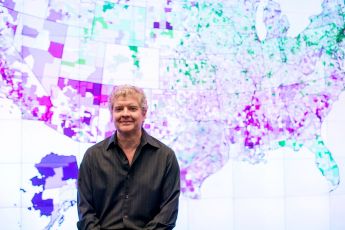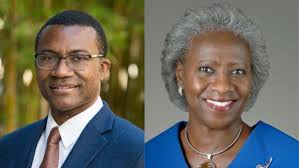

Researchers at Stanford and USC developed a new tool to track neighborhood and school segregation in the U.S.


Racial segregation leads to growing achievement gaps – but it does so entirely through differences in school poverty, according to new research from education Professor Sean Reardon, who is launching a new tool to help educators, parents and policymakers examine education trends by race and poverty level nationwide.

An analysis of census and school closure data finds that shuttering schools increases gentrification – but only in predominantly Black communities.


A new study shows that students assigned to an ethnic studies course had longer-term improvements in attendance and graduation rates.
Stanford sociologist Matthew Snipp discusses ways to educate students about race and ethnic relations in America.

In a new book, Assistant Professor Michael Hines chronicles the efforts of a Chicago schoolteacher in the 1930s who wanted to remedy the portrayal of Black history in textbooks of the time.


Professor Alfredo J. Artiles discusses the complexities in creating inclusive policies for students with disabilities.

New research led by Stanford education professor Thomas S. Dee provides the first evidence of effectiveness for a district-wide initiative targeted at black male high school students.


Stanford education professor Subini Ancy Annamma talks about the role schools play in creating a culture of punishment against Black students.


Stanford psychologists find that brief exercises early in middle school can improve students’ relationships with their teachers, increase their sense of belonging and reduce teachers’ reports of discipline issues among black and Latino boys.


In his new book, Science in the City, Stanford education professor Bryan A. Brown helps bridge the gap between students’ culture and the science classroom.

Stanford psychologists Jennifer Eberhardt and Jason Okonofua experimentally examined the psychological processes involved when teachers discipline black students more harshly than white students.

Travis Bristol, MA '04, talks about what it takes for schools to hire and retain teachers of color.
Research has shown that time and time again, inequality is embedded into all facets of the criminal justice system. From being arrested to being charged, convicted and sentenced, people of color – particularly Black men – are disproportionately targeted by the police.
“So many reforms are needed: police accountability, judicial intervention, reducing prosecutorial power and increasing resources for public defenders are places we can start,” said sociologist Matthew Clair. “But beyond piecemeal reforms, we need to continue having critical conversations about transformation and the role of the courts in bringing about the abolition of police and prisons.”
Clair is one of several Stanford scholars who have examined the intersection of race and the criminal process and offered solutions to end the vicious cycle of racism. Here is some of that work.
Share this card
Researchers examined crime-related posts from 14,000 Facebook pages maintained by U.S. law enforcement agencies and found that Facebook users are exposed to posts that overrepresent Black suspects by 25% relative to local arrest rates.
New data show that a one-page letter asking a teacher to support a youth as they navigate the difficult transition from juvenile detention back to school can reduce the likelihood that the student re-offends.


Stanford sociologist discusses how race and class inequalities are embedded in the American criminal legal system.

Associate Professor Subini Annamma examines the policies and practices that push marginalized students out of school and into prisons.

Stanford scholars Hakeem Jefferson, Robert Weisberg and Matthew Clair weigh in on the Derek Chauvin verdict, emphasizing that while the outcome is important, much work remains to be done to bring about long-lasting justice.


After analyzing 95 million traffic stop records, filed by officers with 21 state patrol agencies and 35 municipal police forces from 2011 to 2018, researchers concluded that “police stops and search decisions suffer from persistent racial bias.”


Analyzing thousands of data points, the researchers found racial disparities in how Oakland officers treated African Americans on routine traffic and pedestrian stops. They suggest 50 measures to improve police-community relations.

As questions about racial bias in the criminal justice system dominate the headlines, research by Stanford law Professor John J. Donohue III offers insight into one of the most fraught areas: the death penalty.
The COVID-19 pandemic has disproportionately impacted communities of color and has highlighted the health disparities between Black Americans, whites and other demographic groups.
As Iris Gibbs, professor of radiation oncology and associate dean of MD program admissions, pointed out at an event sponsored by Stanford Medicine: “We need more sustained attention and real action towards eliminating health inequities, educating our entire community and going beyond ‘allyship,’ because that one fizzles out. We really do need people who are truly there all the way.”
Below is some of that research as well as solutions that can address some of the disparities in the American healthcare system.
Share this card

The American Heart Association has provided funding to two Stanford Medicine professors to develop ways to diversify enrollment in heart disease clinical trials.

Research by SIEPR’s Petra Persson and Maya Rossin-Slater finds wealthy Black mothers and infants in the U.S. fare worse than the poorest white mothers and infants.

A clinical trial in Oakland by Stanford researchers found that black men are more likely to seek out preventive care after being seen by black doctors compared to non-black doctors.

Traditional approaches to pain management don’t treat all patients the same. AI could level the playing field.

Alice Popejoy, a postdoctoral scholar who studies biomedical data sciences, speaks to the role – and pitfalls – of race, ethnicity and ancestry in research.

The event at Stanford provided a venue for health care workers and students to express their feelings about violence against African Americans and to voice their demands for change.

African-American heart transplant patients have had persistently higher mortality rates than white patients, but exactly why still remains a mystery.


Widely used virus tracking data undercounts older people and people of color. Scholars propose a solution to this demographic bias.
Farzana Saleem, an assistant professor at Stanford Graduate School of Education, is interested in the way Black youth and other young people of color navigate adolescence—and the racial stressors that can make the journey harder.


Disparities exist in how babies of different racial and ethnic origins are treated in California’s neonatal intensive care units, but this could be changed, say Stanford researchers.

When states expand public health insurance to include low-income, legal immigrants, it does not lead to out-of-state immigrants moving in search of benefits.

The impact of the COVID-19 pandemic has been starkly uneven across race, ethnicity and geography, according to a new study led by SHP's Maria Polyakova.
Driving Artificial Intelligence are machine learning algorithms, sets of rules that tell a computer how to solve a problem, perform a task and in some cases, predict an outcome. These predictive models are based on massive datasets to recognize certain patterns, which according to communication scholar Angele Christin , sometimes come flawed with human bias .
“Technology changes things, but perhaps not always as much as we think,” Christin said. “Social context matters a lot in shaping the actual effects of the technological tools. […] So, it’s important to understand that connection between humans and machines.”
Below is some of that research, as well as other ways discrimination unfolds across technology, in the media, and ways to counteract it.
Share this card
A Stanford collaboration with the Department of the Treasury yields the first direct evidence of differences in audit rates by race.

The disparity likely occurs because such technologies are based on machine learning systems that rely heavily on databases of English as spoken by white Americans.
Robots, self-driving cars and other intelligent machines could become better-behaved thanks to a new way to help machine learning designers build AI applications with safeguards against specific, undesirable outcomes such as racial and gender bias.

In a recent study, assistant professor of communication Angèle Christin finds a gap between intended and actual uses of algorithmic tools in journalism and criminal justice fields.
In the course CS 181: Computers, Ethics and Public Policy, Stanford students become computer programmers, policymakers and philosophers to examine the ethical and social impacts of technological innovation.


Social scientists found that homicide victims killed in Chicago’s predominantly Black and Hispanic neighborhoods received less news coverage than those killed in mostly white neighborhoods.


New Stanford research shows that, over the past century, linguistic changes in gender and ethnic stereotypes correlated with major social movements and demographic changes in the U.S. Census data.


Stanford HAI’s 2021 AI Index reveals stalled progress in diversifying AI and a scarcity of the data needed to fix it.
From who moves forward in the hiring process to who receives funding from venture capitalists, research has revealed how Blacks and other minority groups are discriminated against in the workplace and economy-at-large.
“There is not one silver bullet here that you can walk away with. Hiring and retention with respect to employee diversity are complex problems,” said Adina Sterling , associate professor of organizational behavior at the Graduate School of Business (GSB).
Sterling has offered a few places where employers can expand employee diversity at their companies. For example, she suggests hiring managers track data about their recruitment methods and the pools that result from those efforts, as well as examining who they ultimately hire.
Here is some of that insight.
Share this cardA written framework is an easy way to hold everyone to the same standard.

A new collection at Stanford Libraries will highlight Black Americans who helped transform California’s Silicon Valley region into a hub for innovation, ideas.

In their evaluations of high-performing venture capital funds, professional investors rate white-led teams more favorably than they do black-led teams with identical credentials, a new Stanford study led by Jennifer L. Eberhardt finds.

People whose employment histories include part-time, temporary help agency or mismatched work can face challenges during the hiring process, according to new research by Stanford sociologist David Pedulla.

Stanford study suggests that the emotions American employers are looking for in job candidates may not match up with emotions valued by jobseekers from some cultural backgrounds – potentially leading to hiring bias.

A field experiment used fake emails to measure gender and racial bias among startup investors.

New research shows a “spillover effect” that might be clouding your judgment.

New research looks at how referrals impact promotions of minorities and women.